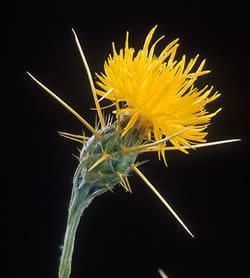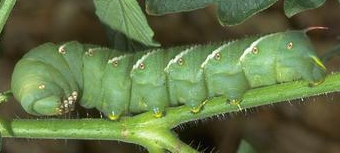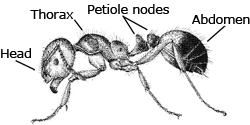By Jeanne Lawrence, Butte County Master Gardener, August 9, 2013
Given the right conditions, some seemingly mild-mannered plants can become garden thugs, invading entire yards and even moving on to the rest of the neighborhood. We may all have heard stories about the bamboo or mint that threatened to take over a garden, but there are other potentially nasty plants lurking out there. In the interest of saving others from the anguish of dealing with unexpectedly invasive plants, our local Master Gardeners (MGs) volunteer the following tales of their own (often on-going) battles with particular members of the plant kingdom.
Violets! Their flowers are lovely, and they create a useful ground cover….and then some. One MG reports with exasperation that they “are truly a pest;” another says that they “will never be gone.” Plus they provide a handy hide-out for leafrollers, the larva of the Geshna Cannalis moth. Leafrollers literally roll themselves up in the leaves. They deform the leaves and will spread to other plants.
Morning glories have proven to be tenacious fighters in many gardens. In particular, the perennial morning glory (often labeled “Heavenly Blue” or “Blue Dawn Flower”) can cover entire buildings, and grows so fast you'd swear you could see it growing while you watched it. One Chico MG reports that it took years to eradicate it from her yard – vines were still emerging in her shady side yard more than five years after she had dug it up from the roots in an attempt to permanently dispose of it. A Durham MG had the same experience.
Another ultra-hardy self-seeder is Scabiosa (pincushion flower). One Chico MG, who has planted two types (atropurpurea and ochroleuca) says that they reseed “almost beyond control.” Because they are so attractive, she feels guilty pulling them up, but knows that, regardless, she can't really get rid of them.
Russian Sage has proven to be very invasive in the Chapmantown yard of a Chico MG, who reports that “it sends up shoots the full length of my house.” Trying to keep it contained by cutting it just encourages the plant to send up more shoots.
Shady Chico yards provide the ideal conditions for the spread of a nearly evergreen species of alstroemeria, the Peruvian Lily A. psittacina. Its dark red flowers marked with green and blotched with dark purple appear in early summer and early fall; the two-foot-tall foliage provides useful ground cover during the winter and dies back in mid-summer. But don't be fooled! Over time this alstroemeria will move into every shady area in a yard and even colonize sunnier locations. It travels by tuberous rhizomes which develop in clusters. Because it is impossible to dig up every single tuber in these clusters, the plant is impossible to eradicate. A Chico MG with a very shady yard knows she will be battling this ultra-vigorous plant for the rest of her life.
A similar story is told by a Chico MG who moved into a house whose previous owner had planted creeping fig vine all along the backyard fence. She reports that the vine has grown in between the fence boards into the yards of the neighbors on all three sides of her lot. She is in the process of removing it by cutting it down and treating the roots with herbicide, and laments that even with this on-going vigilant approach, it will take several years to get rid of it.
Up in Paradise, an MG planted one yellow flag iris (pseudacrus) ten years ago in a semi-shady location with spring water available all year. She now has an area eight feet long and four feet wide filled with these plants, which die to the ground in cold weather. “The roots are enormous,” she says, adding that “It would require a back hoe to dig them out.”
Finally, a Durham MG has been dealing with the Miner's lettuce planted by his home's previous occupant for twenty years. Initially, he says “it was so thick I couldn't mow it and had to use a weed eater,” and it still sends up a few shoots each year. He has seen this plant advertised in a seed catalog and warns “someone would have to be insane to sow it without putting it in a container.”
The bottom line: Think twice (or three times) before planting these potential garden invaders!
http://www.plantright.org/map
http://www.ipm.ucdavis.edu/PMG/PESTNOTES/pn74139.html
By Brent McGhie, Butte County Master Gardener, July 26, 2013
The University of California recommends the use of Integrated Pest Management (IPM) to control garden pests. The goal of IPM is to use the least harmful control method(s) that will be effective in managing a particular pest. Depending on the pest, these methods include one or more of the following: cultural controls, biological controls, mechanical and physical controls and chemical controls (pesticides). When using IPM, it is recommended that gardeners resort to the use of pesticides only as a last resort, after other control methods have been tried and found wanting.
Before using a pesticide, be certain a pest is the actual cause of the problem you are experiencing. For example, plants can be damaged by incorrect watering, poor drainage, accidental herbicide exposure, or physical damage from wind, hail, sun scorching and other weather-related factors. A decision should also be made on how much damage you are willing to tolerate. Minor surface blemishes on fruit caused by thrips are probably an acceptable alternative to pesticide use. Once it has been determined a pest is present and is causing a major problem, identify the pest and research alternative control methods. If you need help, your Butte County Master Gardeners can provide guidance in these areas. In most cases, even if a pesticide is utilized, a combination of measures will provide the best long-term control.
Once the decision to use a pesticide has been made, the next step is to choose the right pesticide. The University of California Pest Notes series is a good source of information for identifying the least toxic pesticides appropriate for a specific pest. Low toxicity pesticides include insecticidal oils and soaps as well as the microbial insecticide, Bacillus thuringiensis, which is effective against many caterpillars, but nontoxic to other animal life. Pest Notes are available from your local Master Gardener program (based at the UC Cooperative Extension Office) and online at the UC Statewide IPM Program website (http://www.ipm.ucdavis.edu/index.html)
Before purchasing a pesticide read the label to be certain the plant you plan to use it on is listed on the label. Never use pesticides designated for use on ornamental plants on plants that will be eaten unless they are also listed on the label. Also, be aware that most pesticides only control certain stages of a pest’s life cycle. For disease control it is important to remember that fungicides are preventive and, although they may slow the progress of an existing infection, they will not eliminate it. Herbicides may be pre-emergent (preventing weeds from germinating successfully), or post-emergent (designed to kill actively growing weeds). Herbicides may also be broad-spectrum (killing weeds of almost any type), or selective in the type of weeds they affect.
Whenever a pesticide is used, all instructions should be read and carefully followed. Especially critical are instructions concerning proper application and safety precautions (for example, the use of protective clothing and eyewear).
To minimize pesticide contamination of the environment, mix only what is needed for immediate use and never use more than what the directions recommend. To further limit environmental exposure, avoid widespread applications; instead, apply only to affected areas. Do not spray during windy conditions when pesticides can be blown away from their intended target. To prevent contamination of waterways, avoid spraying near storm drains, creeks, or other bodies of water. It’s important that the application dry on the target before it gets wetted by rain or irrigation. Unless otherwise specified, do not spray just before irrigating, or before rainy weather. Additionally, be aware that spraying pesticides on hard surfaces such as foundations, driveways or sidewalks increases the likelihood that they will be washed off into storm drains.
The only legal way to dispose of pesticides is to take them to a local hazardous waste disposal facility. Do not pour unused or excess material down the drain, onto the soil, into waterways, into gutters, or into the trash. However, in California it is legal for homeowners to dispose of empty pesticide containers in the trash. Before disposing, containers should be triple rinsed and the rinse water used as part of the last application. To find the location of the closest hazardous waste disposal site, call the California Environmental Hotline (1-800-253-2687), or visit the “Earth911” website.
Information in this article is based on “Pesticides: Safe and Effective Use in the Home and Landscape” at UC IPM Online (Pest Note #74126).
By Michele Carter, Butte County Master Gardener, July 12, 2013

Yellow starthistle seeds germinate from fall through spring, corresponding to the normal rainy season in California. After germinating, the plant allocates most of its resources to root growth and by late spring, roots can extend over 3 feet. The plant exists as a short rosette amongst other weeds until it begins to flower.
The foliage of this plant ranges from gray-green to blue-green; once flowering begins it can easily be identified by its bright, thistle-like yellow flowers, which have sharp spines surrounding their bases. This weed grows from 6 inches to up to 5 feet.
Yellow starthistle forms dense infestations and rapidly depletes soil moisture, preventing the establishment of other species. It is also poisonous to horses, causing a nervous disorder called “chewing disease” (nigropallidal encephalomalacia), which is fatal once symptoms develop. Horses are the only animal known to be affected – they should not be allowed to graze on yellow starthistle.

Yellow starthistle can be spread as a contaminant in grass seed and in all classes of hay, particularly grass hay. Hay used as mulch along roadsides or disturbed areas can be a source of yellow starthistle. Livestock that have fed in areas infested with yellow starthistle can be transporters of the seed.
Because the seeds germinate during the rainy season, a single cultivation after the rainy season, when soils are dry, effectively controls yellow starthistle seedlings and rosettes. Timing is critical: this cultivation must take place in late spring after the last rains but before seeds are produced.
Mowing can be used to manage starthistle. Be sure to mow well before starthistle is in full flower or has set seed. Mowing is most effective when soil moisture is low and no irrigation or rainfall follows mowing. If rain occurs after you've removed existing plants, seeds will continue to germinate and the eradication process must be repeated. Pre-emergent and post-emergent herbicides can also be helpful in controlling growth and infestation of starthistle.
Lastly, effective management of starthistle includes revegetation. Planting affected areas with desirable plants discourages starthistle regrowth by creating competition.
For information about herbicides and for photos of yellow starthistle's growth cycle, visit http://www.ipm.ucdavis.edu/PMG/PESTNOTES/pn7402.html
By Michelle Ramsey, Butte County Master Gardener, June 28, 2013
If something is eating your tomato plants or your eggplants, hornworms may very well be the culprit.
Two common species of hornworms seen in the garden are the Tomato Hornworm (Manduca quinquemaculata) and the Tobacco Hornworm (Manduca sexta). They can be differentiated by how many white stripes the larvae have on each side of their bodies. Tobacco hornworm larvae have 7 diagonal stripes on each side, while the tomato hornworm larvae have 8 chevron-shaped stripes. Mature hornworm larvae can be very large, up to 4 inches long (they will most likely be the largest “caterpillar” you’ll see in your garden). Hornworms feed on blossoms, leaves and fruit and are particularly known to cause damage to tomatoes and eggplants. Damage to plants typically occurs in mid-summer (but may also be seen in late summer). In their larval stage, hornworms are green caterpillars often seen hanging upside down on the plants. They have a “horn” at the rear end of their body. In the early summer, hornworm eggs (laid singly on leaves), hatch into larva. The larvae feed on leaves for 3-4 weeks and then burrow into the ground to pupate. The pupa over-winter in the ground and then emerge as adult moths. Adult hornworm moths are strong fliers with a wingspan of up to 5 inches.
The larval form of the hornworm is the only stage that causes damage to your plants. Hornworms can be hard to find as their green coloring provides a nice camouflage for them amidst the tomato plant leaves. Foliage damage (and possibly some damage or scarring of fruit) and large droppings on the dirt under the plants are indications that hornworms are present in the garden. When the plant is shaken gently hornworms will sometimes make a clicking sound which can help you locate the intruder. Natural enemies of hornworms are the Trichogramma parasitic wasp which lays eggs in the hornworm eggs and the Hyposoter exiguae parasitic wasp which infests the hornworm larvae as a parasite.
The most common methods of hornworm management are hand-picking them off plants and/or snipping them with shears. However, if the hornworm infestation is out of control, an organic spray (Bacillus thuringiensis or Spinosad) may be applied. These sprays are effective against smaller hornworm larvae but will not destroy the natural enemies of the hornworms. Crop rotation and disking (breaking up and turning over the soil) after harvest destroys pupae in the soil, and will help prevent emergence and a repeat of the hornworm life cycle in your garden the following year.
For additional information visit:
http://www.ipm.ucdavis.edu/PMG/r783301111.html
By Michelle Ramsey, Butte County Master Gardener, June 14, 2013
We often experience ants in our homes when weather conditions change. They are typically looking for food, water, warmth, and/or protection from extreme weather conditions. Ants belong to the insect order Hymenoptera and are close relatives of bees and wasps. The most common outdoor ant found in California is the Argentine worker ant. The Argentine worker ant is approximately 3mm long, dark colored and does not sting. They have no natural enemies. Their colonies have multiple queens and only the queens lay eggs. An ant’s life cycle moves from egg to larva to pupa to adult. Their nests are normally found in moist soils, under debris or along sidewalks and driveways. Argentine ants are drawn to sweet foods but will also feed on protein (e.g. dead bugs). The Argentine ant will venture up to 100 feet away from the nest to find food, water and shelter inside buildings. Once inside, if ants find food, they will continue to invade until the food source is removed and/or the entryway sealed.
While it is not realistic to eradicate all ants from your backyard, you can effectively reduce the number of ants entering your home by following a 3-Step integrated approach as follows:
Minor Indoor Problem (small trail of ants observed infrequently). Prevent further intrusion by:
1) Identifying the location where the ants are getting into the house. Inspect baseboards, floors, electrical outlets, vents, pipes, drains and walls for any entryways and seal them off (caulk is good for this). Destroy any nesting sites found close to the house. Cut back trees, shrubs or wooded material touching the house and clear away mulch or debris that is next to the house.
2) Clean up food and water sources in the home. All sources of “attractive” food should be removed or securely sealed. Use soapy water to kill ants and eliminate their trails.
Moderate (trails of hundreds of ants) and severe (several hundred to thousands of ants continue to invade for weeks or months). Supplement steps 1 and 2 above with the addition of bait stations as follows:
3) Install bait dispensers around the outside of the house (UC Researchers have had success using bait dispensers such as KM AntPro Liquid Bait Dispenser). Baits are more effective and less toxic than traditional pesticide treatments for ants. Baits are insecticides mixed with materials that attract worker ants. The advantage of a bait station over an insecticide spray is that the spray only kills the worker ant while the bait station allows worker ants to take the bait back to the colony to feed and kill the colony ants, including the queen ant. When all the queens die, the colony is destroyed. Continue to refill dispensers regularly with liquid borate-based bait until the ant problem ceases. It is critical that you select the right bait/attractant for Argentine ants (liquid baits with 1% or less borate are suggested). Install at least one dispenser on each side of the house, next to structures where ants are trailing (but at least 5 ft. from any nest). Keep ant bait stations out of direct sunlight.
Following the 3-step approach above should correct home ant invasions.
For more information visit:
http://www.ipm.ucdavis.edu/PMG/PESTNOTES/pn7411.html




